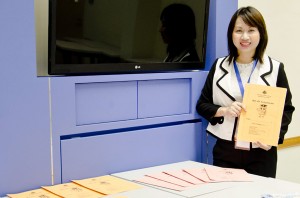Why Singapore’s English Teachers Should Embrace Singlish, Not Fight It
Is it time for Singaporean educators to embrace Singlish as a legitimate learning tool? What the Research […]
Read More
Creativity abounds at Pei Chun Public School, even when it comes to reading. At the school, pupils get to create and write their own mini-books. Some of them also design virtual posters for the books they have read. These are all part of a comprehensive programme to cultivate a love of reading in them.
Delivering a sustainable approach to cultivate a love for reading in their pupils is the main aim of Pei Chun Public School’s reading programme. Known as iREAD, the programme is a bottom-up initiative started by two senior teachers in 2010. One of them is Mrs Rachel Gan-Goh.

As a Special Assistance Plan (SAP) school, Pei Chun’s pupils should be proficient in both the English and Chinese languages. But Rachel found that they tend to read more English than Chinese books.
To synergize the strengths of their library instructional programme for English language and the Chinese reading programme, she and her colleague developed the iREAD programme – Integrated Reading for Enjoyment, Achievement and Development – to bring about a balance in their pupils’ reading diet.
Today, iREAD has become a whole-school programme that integrates reading in both languages and the use of information and communications technology (ICT).
Every alternate week, the pupils look forward to going to the computer laboratory during their language lessons. That is where, among other activities, the upper primary pupils work individually to create virtual posters, or glogs, of books they have read.
– Rachel Gan-Goh, Pei Chun Public School
“They use Glogster as a showcase of the books they have read,” Rachel explains. “It allows children to put ideas together – things that children would otherwise just cut and paste on a paper poster.”
Rachel strongly believes that Glogster, a free online platform, has a lot of curriculum potential. The features that pupils create in their virtual posters include audio recordings of their opinions on the book, links to other websites, and images of the books they read. The poster serves as a reflection tool for the pupils as well, as they also have to review the book and decide if they would recommend it to others.
For the Chinese iREAD programme, the post-reading activity involves pupils creating their own physical storybooks from scratch.
“It can be a one-page book for lower primary pupils, or it could be a four-page book that has orientations, a problem, a climax, a resolution for the upper primary pupils,” Rachel says. “Or it could be in the form of what we call the big-mouth book.” (See photo gallery)
“I think the task of making books lends itself well to getting children to manage complexities,” Rachel explains. “Because boundaries are not well-defined, they first learn to problem-find before making decisions.”
 The acts of determining the plot, drawing and colouring the characters, cutting and folding the book all stimulate creative and inventive thinking in these young readers.
The acts of determining the plot, drawing and colouring the characters, cutting and folding the book all stimulate creative and inventive thinking in these young readers.
The use of Glogster also helps to develop reflective thinking in pupils. At a tender age, these pupils get to practise how to see things from different perspectives. While designing glogs, they have to think like the author who writes for an audience. And when writing a review, they think like a reader who critiques a book.
“It’s a complex task and they must actually think about how to manage it,” Rachel adds. “It builds perspectives and helps to develop reflective thinking.”
To ensure the success of the iREAD programme, which was also showcased at this year’s MOE Excel Fair, Rachel says, “We have to consider how best to leverage the love for reading rather than just having another add-on reading programme because if it is a chore, children wouldn’t like to read.”
iREAD has proved to be a success with the pupils for the past 3 years, because it has made reading that much more fun for them.